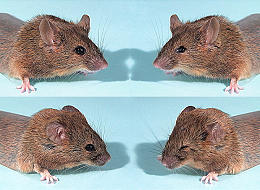Prev reverse evolution in mice.
American scientists brought a mouse back to about 500 million years ago by reversing the evolutionary process. By changing the mouse's genetic pattern, scientists created a gene found in ancient animals.

(Photo: deseretnews.com)
This ancient gene then develops into a new form and subdivides, creating a pair of genes that play a major role in the development of brain in mammals today.
Scientists say these experiments have shed more light on the evolutionary process and may bring new techniques for gene therapy (and possibly many new genetic engineering-based therapies). born)
"We first recreated an ancient gene and we have shown that from these two modern, specialized genes, we can replicate the ancient gene, separate it from the other two specialized genes." scientist Petr Tvrdik of Utal University joined the study.
"This ancient gene sheds light on the mechanism and process of evolution and tells us more about how the world of nature has transformed life."
Brain development.
The study refers to a set of genes related to early development, published in the academic journal "Developmental cells".
It was not until 500 million years ago that early animals had 13 Hox genes. Then each gene is divided into 4, forming 52 genes.
During evolution, the gene mutation kept going on, some genes became unnecessary and disappeared, resulting in the number of Hox genes remaining at 39 in today's animals.
The University of Utah team studied two of these genes; It is the Hoxal gene, the gene that controls early brain development and the gene Hoxb1, which plays a key role in neuronal development that controls the emotional expression on the face in animals.
Hybrid genes.
The Utah team combined important parts of each gene together, recreating a gene similar to that at about 530 million years ago.
The hybrid gene is not exactly the same as the ancient gene, but scientists say it basically has the same functions.
"What we are doing is essentially going back to the time when the ancient Hox1 gene had the same functions as the Hoxa1 and Hoxb1 genes today.
"Ancient genes are a practical example of how evolution has evolved because we can reverse evolution."
The mouse still looks the same but carries the ancient gene.
- Biological evolution
- The mole rats eat the mouse rat manure to get instructions for raising children
- New threat from European house mice
- Observe the extremely rare 'reverse evolution' lizard species in the natural world for the first time
- Listen to mice 'sing' like birds
- The truth is hard to believe: A pair of experimental mice can be as expensive as a billion-dollar car
- Young blood - the key to preventing aging?
- Special 'reverse' filter: Only large objects are allowed to pass
- Small animals like mice can be as big as elephants after 24 million generations
- Scientists have created transparent mice
- Successfully cloned mice from a drop of blood
- This is evidence that human evolution is still very much 'error'.
 Animal 'suffering' after hibernation
Animal 'suffering' after hibernation Why do goats climb well?
Why do goats climb well? Scientists were surprised to see chimpanzees eating turtles
Scientists were surprised to see chimpanzees eating turtles Giant catfish died deadly due to drought in Thailand
Giant catfish died deadly due to drought in Thailand